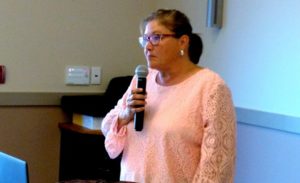Aaamjiwnaang First Nation takes charge with environmental protection projects

By Colin Graf
AAMJIWNAANG FIRST NATION—Residents of Sarnia were surprised during a recent presentation about the depth and determination of their next-door neighbours’ work to monitor environmental hazards and improve living conditions.
Sharilyn Johnston, Aamjiwnaang’s environmental coordinator, told the Green Drinks group of Sarnia that the First Nation is involved in a large number of projects, from monitoring air pollution from the chemical plants surrounding the community, to wildlife habitat restoration, to detailed consultation with industry and other proponents about new development.
Johnston told the group that in recent years, Aamjiwnaang has been involved in protecting habitat for local reptile populations. Efforts include the creation of a “turtle garden” and securing habitat for the endangered Butler’s Gartersnake, along with working to restore a portion of the St. Clair River’s edge to natural condition to help with fishing access and encourage the spawning of various species. She explained how the First Nation also has set up a greenhouse and rescues native plants from areas undergoing development with money donated by local industry. The plants are then propagated and used to naturalize areas on and off the community’s land, as well as being sold to the public.
Aamjiwnaang is also starting an air-monitoring program to catch “fugitive emissions” of the carcinogenic chemical benzene from local plants, Johnston added. The First Nation has partnered with the province and federal governments to create a website that provides the public with real-time air quality data for the area. The First Nation is also teaming up with agencies including the Ontario Ministry of the Environment in a health study to determine if the community is suffering from excessive levels of lung disease and cancers, and if those are due to industrial air pollution.
There is local concern that the new government in Ontario may back away from some of the recent promises made by the previous government surrounding environmental work in the Aamjiwnaang-Sarnia area, Johnston told the group.
Chief Joanne Rogers has drafted a letter to the new Environment minister “indicating we are still committed, we still have an interest, and we’re still looking at keeping the Ministry involved and accountable for the promises and commitments they made around the health study,” and other matters, she told the group at the Aamjiwnaang Community Centre.
Explaining the consultation process, Johnston said her office is dealing with numerous industrial developments from across Aamjiwnaang’s traditional territory, stretching from Sarnia north along the Lake Huron shore to Goderich and inland beyond London to Woodstock.
“People get nervous about consulting with us,” she told close to 40 guests, but “we just want you to come and talk to us, we’ll let you know what our concerns are”.
Aamjiwnaang staff or consultants will review work plans, conduct peer reviews, observe in the field, look for species at risk, or conduct archeological surveys, she explained. Johnston and her four staff will sometimes try to improve or change developments to ensure wildlife corridors are created and to protect other aspects of the environment, she said.
If a developer plans to consult Aamjiwnaang, then Johnston says to engage early because her department always consults with the community, and it sometimes “takes longer to make decisions in First Nation communities,” she explained to the audience.
The community hopes to “create a meaningful relationship” with neighbouring industries through respect, inclusion, trust, and engagement. That allows the consultation process to become “a catalyst for reconciliation,” she explained to the Green Drinks audience, a social networking group for people interested in environmental issues in the Sarnia area.
Bev Takaoka, a retired process engineer who did environmental work for a Chemical Valley company was “really impressed with how involved” Aamjiwnaang is with environmental protection. She was surprised by “the amount of work they’ve put in to create a parallel review process so they can work with industry…. and do a meaningful review” of development projects.
During her working life, Takaoka said consultation with First Nations was “kind of a black box”, when a company would approach Aamjiwnaang with a project and expect an approval back right away.
“There wasn’t a lot of to-and-fro.”
She believes the kind of consultation process outlined by Johnston is much more complex today.
Green Drinks organizer Monica Shepley said the group was excited to come to Aamjiwnaang to hear Johnston’s presentation and to visit the greenhouse. She felt impressed to learn about how many environmental projects are going on in Aamjiwnaang.
“I find it interesting they have paid staff doing this when the city doesn’t and the county doesn’t. We have only volunteer committees,” says Shepley.
Aamjiwnaang’s environment department has existed for just over 10 years, Johnston said, and the large range of work going on is due to a strong commitment from the community.


